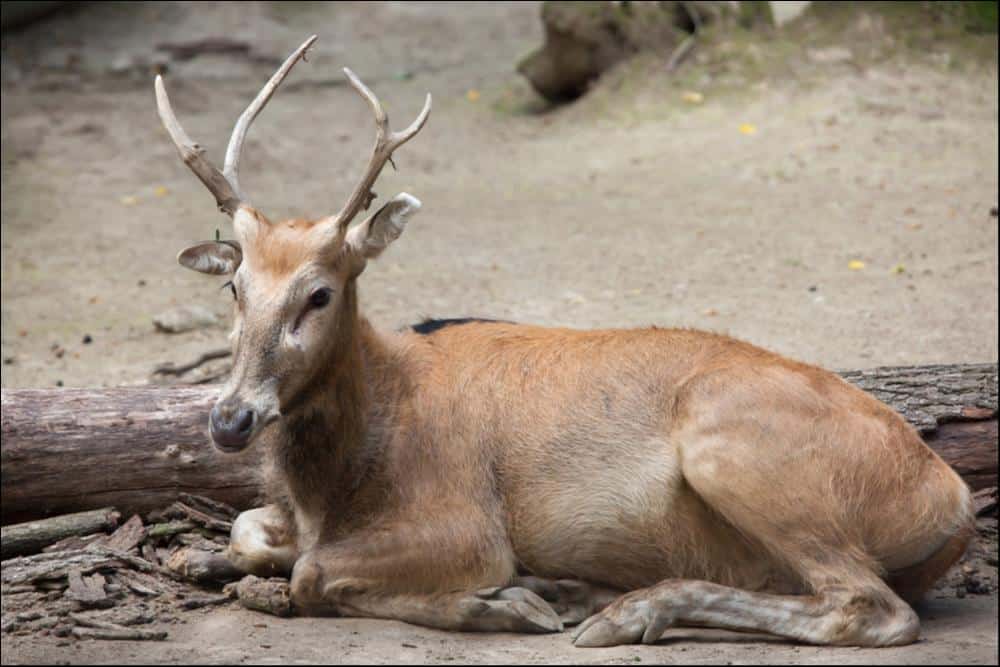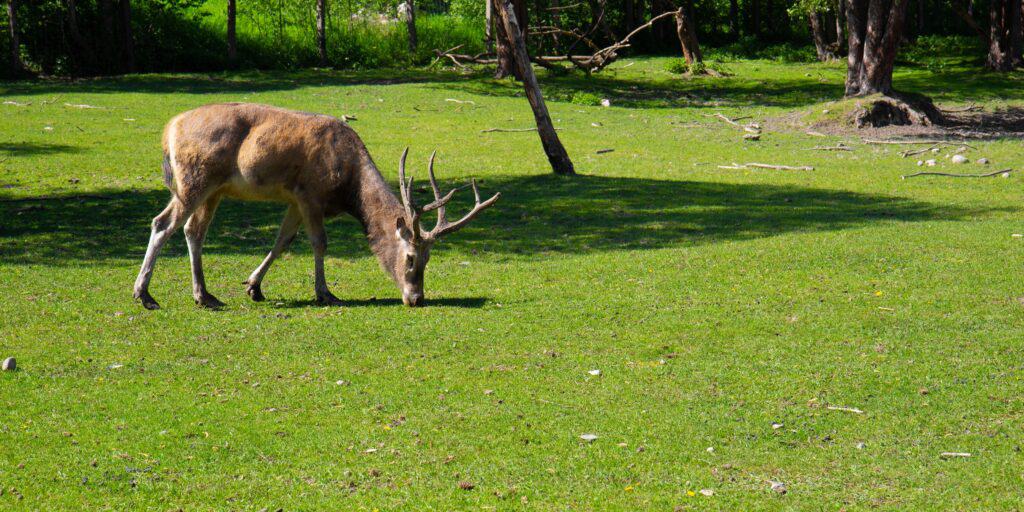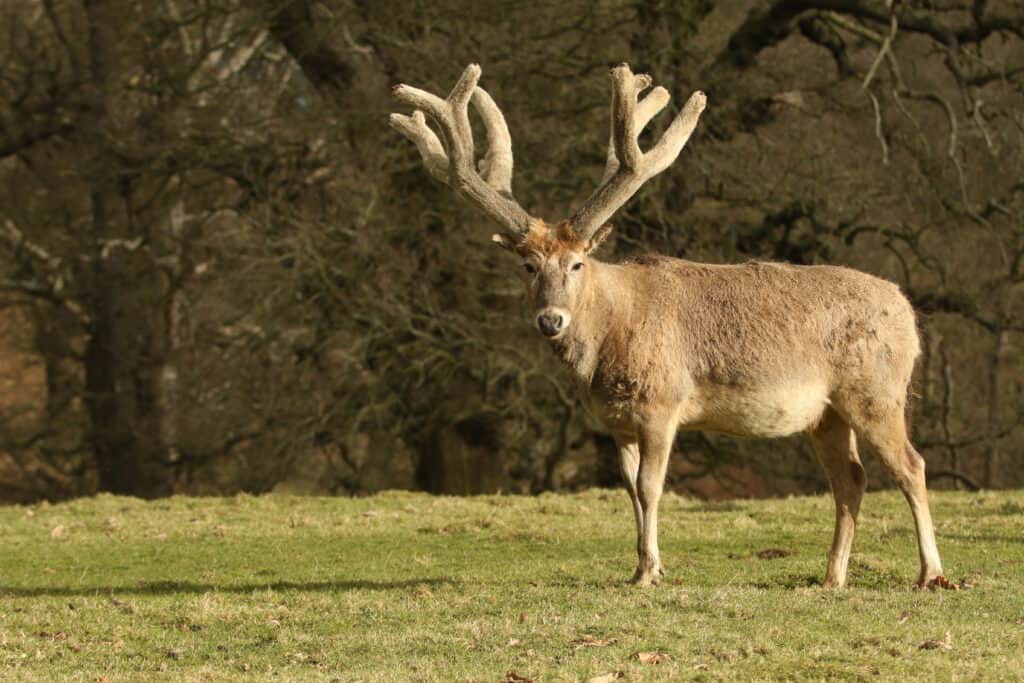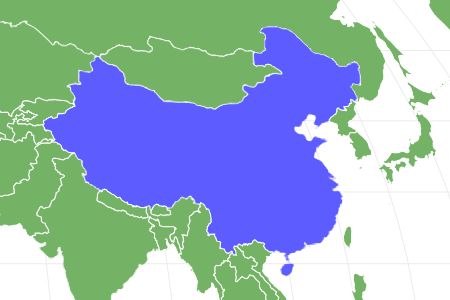Père David’s Deer
Elaphurus davidianus
Has webbing between its toes, aiding in swimming!
Advertisement
Père David’s Deer Scientific Classification
- Kingdom
- Animalia
- Phylum
- Chordata
- Class
- Mammalia
- Order
- Artiodactyla
- Family
- Cervidae
- Genus
- Elaphurus
- Scientific Name
- Elaphurus davidianus
Read our Complete Guide to Classification of Animals.
Père David’s Deer Conservation Status
Père David’s Deer Facts
- Name Of Young
- Fawn
- Group Behavior
- Social
- Estimated Population Size
- Less than 2,000
- Biggest Threat
- Loss of habitat and hunting
- Most Distinctive Feature
- Long legs, webbed feet, spread hooves
- Distinctive Feature
- Long legs, webbed feet, spread hooves
- Other Name(s)
- Milu, Elaphure
- Gestation Period
- 9 Months
- Litter Size
- 1
- Habitat
- Swamps and marshlands
- Predators
- Tigers, humans
- Diet
- Herbivore
- Average Litter Size
- 1
- Lifestyle
- Diurnal
- Common Name
- Pere David's Deer
- Location
- Northeastern and east-central China
- Slogan
- Has webbing between its toes, aiding in swimming!
- Group
- Mammal
Père David’s Deer Physical Characteristics
- Skin Type
- Hair
- Top Speed
- 18 mph
- Lifespan
- 18 years
- Weight
- 298 - 441 lbs
- Height
- 3.9 ft
- Length
- 6.5 ft - 7.21 ft
- Age of Sexual Maturity
- 2 years and 3 months
- Age of Weaning
- 3 Months
View all of the Père David’s Deer images!

“A Pere David’s deer has webbing between its toes and is an excellent swimmer”
Pere David’s deer live in large groups. They are herbivores that mostly eat grass. The average lifespan of this deer is 18 years. Most female Pere David’s deer have just one baby or fawn. A fawn stands up and nurses its mother within hours of being born.
5 Pere David’s Deer Facts

Père David’s deer originate from the northeastern and east-central regions of China.
©iStock.com/wrangel
- Pere David’s deer are from the northeastern and east-central parts of China
- They live in swamps and marshlands
- These deer have spread hooves with webbing to help them swim
- They are social animals living together in large groups.
- These deer have a reddish coat in the summer and a gray coat in the wintertime
Scientific Name

Though commonly known as Pere David’s deer, this animal is formally referred to by its scientific name, Elaphurus davidianus.
©Number One/Shutterstock.com
While Pere David’s deer is this animal’s common name, its scientific name is Elaphurus davidianus. The Latin term Elaphurus means it belongs to the Cervidae (deer) family.
Davidianus refers to the French zoologist and Catholic Priest Father Armand David who discovered this deer in China. The family of this deer is Cervidae and its class is Mammalia. In France, the word for Father is Pere so the literal translation of this mammal’s name is Father David’s deer.
The Chinese have another name for the Pere David’s deer. The word is sibuxiang and means ‘four not alike’. This refers to the fact that this mammal has hooves like a cow, the neck of a camel, the tail of a donkey, and the antlers of a deer. In other words, this deer has the features of four animals all rolled into one!
Evolution and Origins
The Père David’s deer (Elaphurus davidianus), alternatively called milu or elaphure, belongs to the deer species found in China’s subtropical river valleys. Its diet primarily consists of grass and aquatic vegetation. It stands as the sole surviving species within the Elaphurus genus.
Additionally, the Père David’s deer faced a big threat because people hunted them a lot and their homes disappeared. Europeans took the remaining deer to zoos in Europe before 1912. Almost 100 years later, in 1985, China got 38 deer back to reintroducing them into the wild.
Further, the Père David’s deer stands out among deer. It has large antlers on a horse-shaped head, a donkey-like tail, and cow-like hooves, but with webbed toes for swimming.
Appearance and Behavior

The coat of a Pere David’s deer is reddish-brown and features a black stripe across its shoulder.
©Sandra Standbridge/Shutterstock.com
In the summertime, a Pere David’s deer has a reddish-brown coat with a black stripe on its shoulder. But, in the winter, its coat turns grayish brown. These colors help to camouflage the deer during different seasons. Male Pere David’s deer have antlers that measure 21 to 31 inches in length.
Antlers that are 31 inches long are equal in length to 2 stacked bowling pins. Male deer use their antlers to fight other males when competing for females during mating season. These deer may rear up on their hind legs and clash their antlers together in combat.
A Pere David’s deer is 6 ½ to a little over 7 feet long. A 7-foot-long deer is as long as a large Christmas tree. Also, this deer can weigh from 298 lbs to 441 lbs A 441 lbs Pere David’s deer is equal in weight to half of a full-grown horse. While 441 lbs is the heaviest weight of a Pere David’s deer, a Whitetail deer can grow to be a little over 500 lbs.
The Pere David’s deer have hooves, but they are different from the hooves of other types of deer. Most deer have hooves that are narrow with the toes pressed close together. Alternatively, a Pere David’s deer has hooves that are spread out with webbing between their toes. Why? These hooves help to move Pere David’s deer through the water as they swim in swamps and marshes. Many of these deer spend a lot of time standing in water that can go as high as their shoulders.
The unique design of this deer’s hooves is great for swimming, but they don’t particularly add to its speed. A Pere David’s deer can only run about 18 miles per hour. Compare this to a Whitetail deer that can reach speeds of up to 30 miles per hour or a Reindeer that can run 50 miles per hour!
These deer are social, outgoing mammals and like to live in large groups sometimes called a herd, gang, or mob. When Pere David’s deer were plentiful, there may have been dozens or even hundreds of deer in a herd. Plus, living in a herd provides protection from a predator such as a tiger. Once the deer start running, a tiger has a challenging time finding and separating one deer to attack. In addition, a group of running deer can injure a tiger that’s trying to enter the herd.
Habitat
Pere David’s deer are from northeastern and east central China. They are originally from a subtropical climate living in marshlands and around swamps. Their webbed hooves allow them to spend a lot of time swimming. Their hooves also offer them support while walking in muddy, soggy areas.
Diet
What do Pere David’s deer eat? They are herbivores and eat a diet of mostly grass. However, if grass is in short supply, especially during the wintertime, they will eat aquatic plants that grow in and around the marshlands.
Pere David’s deer instinctively know what types of grasses and plants to eat. But, if they eat grass or other vegetation that’s been contaminated with chemicals or pesticides they can become very ill or die.
Predators and Threats

The Pere David’s deer holds the official conservation status of being Extinct in the Wild.
©Ivonne Wierink/Shutterstock.com
The official conservation status of the Pere David’s deer is Extinct in the Wild. Back in the late 1800s, there were just a few of these deer left in China. Their population had been greatly reduced by people hunting and eating them.
A small group of these deer belonged to the Emperor of China named Tonghzi. But, a flood knocked down a fence where the deer were kept, and they escaped. Those deer were hunted and eaten by peasants and soldiers in the area. So, when they lived in the wild, their main predator was man. Tigers also preyed on Pere David’s deer.
Today, there’s a relatively small number of Pere David’s deer living in captivity in zoos and sanctuaries. Efforts are being made to increase the population of these deer while they are living in protected areas.
Reproduction, Babies, and Lifespan

Pere David’s deer have a mating season in June. Males mate with one female or more.
©Alex Polo/Shutterstock.com
Mating season is in June for this deer. A male Pere David’s deer joins a group of females to mate with one or more. During this time, the male deer is likely to fight with other male deer to protect the group of females he is with. Male deer hit or box each other with their antlers as a way of fighting. The stronger male wins.
A female’s gestation period is about 9 months and she gives live birth to a baby, also called a fawn in April or May. Most female Pere David’s deer have one fawn. Having two fawns at a time is rare. Fawns weigh between 25 lbs and 29 lbs at birth and start growing quickly!
Like other fawns, these deer are born with white spots on their coat. The spots disappear as they grow older. A fawn can see when it’s born but can’t walk right away. However, a fawn struggles to get up and put weight on its legs almost immediately. This makes a lot of sense. If the newborn fawn stayed on the ground in the wild, it would be vulnerable to predators such as tigers or corsac foxes.
A fawn nurses its mother until they are weaned and begin to eat grass with the older deer. A fawn stays with its mother for about 14 months when it’s ready to survive without help from her.
Pere David’s deer live to be about 18 years old in the wild. The oldest a Pere David’s deer has lived is 23 years and that was in captivity where these deer are well-cared for.
As these deer grow older they’re prone to diseases affecting their muscle tissue also known as myopathy. Incidentally, this type of myopathy is similar to equine myopathy occurring in horses.
Population
Though Pere David’s deer’s official conservation status is Extinct in the wild, there are some exceptions. The efforts made by conservationists to increase the population have begun to work. Some of these deer have been released back into the wild in the hopes they will breed and increase the population even more. Also, there are still many Pere David’s deer being cared for in zoos and other sanctuaries. The population is estimated at around 2000.
One of the reasons for the slow population growth of this mammal is a female deer only has one baby per litter. But, if the population of Pere David’s deer continues to grow, it may receive a new, updated conservation status.
FAQ
Is the Pere David’s deer extinct?
Officially, Pere David’s deer are listed as Extinct in the Wild. But, this doesn’t mean there are none in existence anywhere. Breeding programs have allowed the release of some of these deer back into the wild. In addition, there are Pere David’s deer on display at various zoos in China, the United States, and elsewhere.
How many Pere David’s deer are left?
Approximately 2,000 of these deer are left in the world. Conservationists are working to increase this deer population each year.
How did the Pere David’s deer become extinct in China?
The Pere David’s deer became extinct in the wild in China because they were regularly hunted for food or sport. Also, the loss of their wetland habitat contributed to the massive drop in this deer population. Road construction is one thing that is taking wetland space away from Pere David’s deer and other animals that live there.
What does a Pere David’s deer eat?
This deer eats grass on a daily basis. However, if grass is not plentiful at various times of the year, they will eat aquatic plants growing in the marshlands.
Who discovered Pere David’s deer?
This deer gets its name from the Catholic priest and zoologist/botanist who discovered it. His name was Father Armand David. He discovered this deer as well as many other species of animals and plants on his expeditions to China in the mid-1800s. He was sent there to document these species so others could learn more about them.
View all 192 animals that start with PPère David’s Deer FAQs (Frequently Asked Questions)
Are Pere Davids Deer herbivores, carnivores, or omnivores?
Pere Davids Deer are Herbivores, meaning they eat plants.
What Kingdom do Pere Davids Deer belong to?
Pere Davids Deer belong to the Kingdom Animalia.
How fast is a Pere Davids Deer?
A Pere Davids Deer can travel at speeds of up to 18 miles per hour.
Thank you for reading! Have some feedback for us? Contact the AZ Animals editorial team.


















